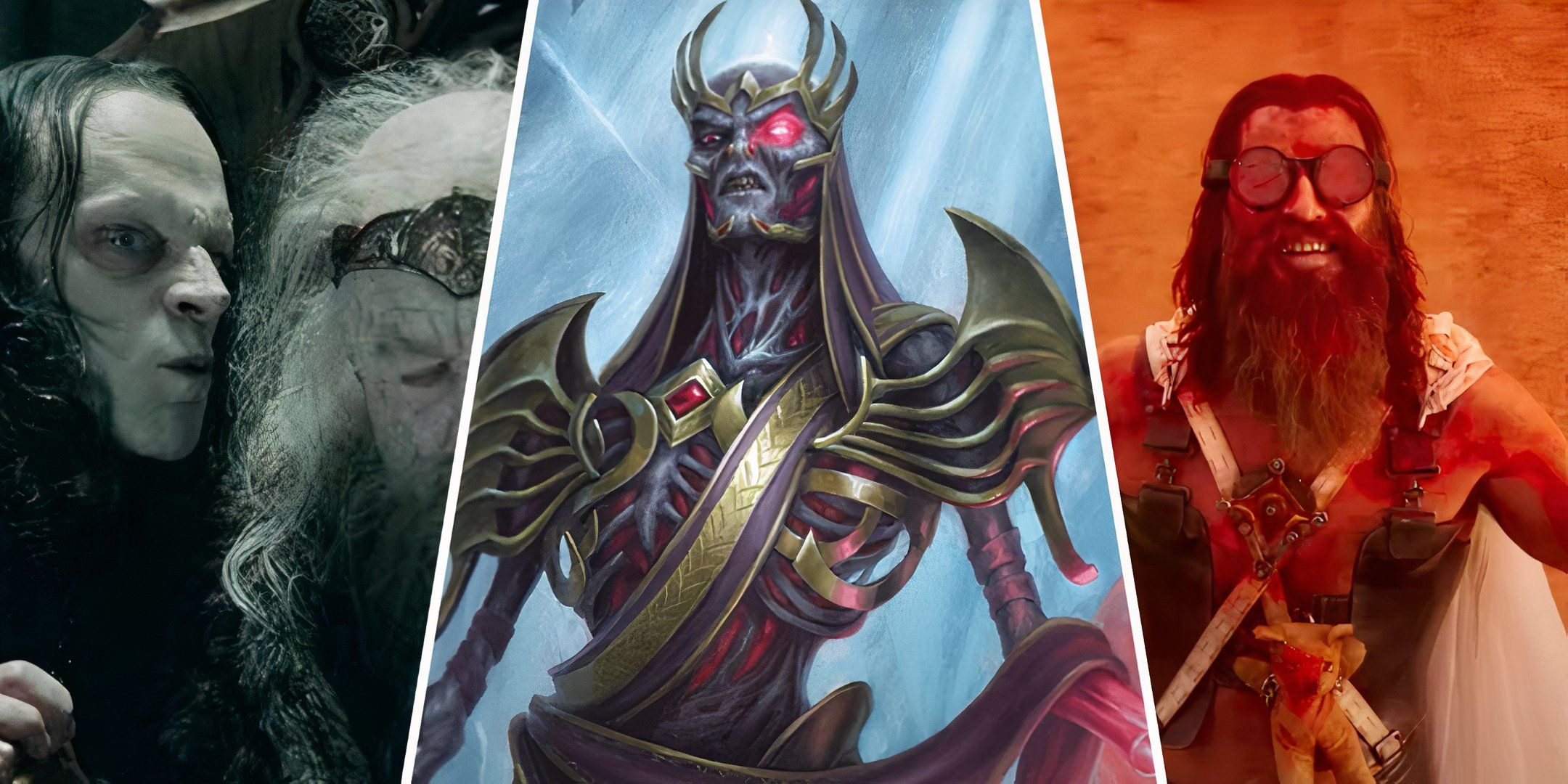Dungeons & Dragons: 10 Archetypes That Make Great Villains

Summary
- Iconic villains in D&D have recognizable archetypes for players to create memorable foes.
- Characters like Tricksters, Mad Scientists, and Tyrants offer unique challenges for players to overcome.
- Ancient Evils and Masterminds represent the ultimate threats, requiring careful planning and strategy to defeat.
Dungeons & Dragons is known for its iconic villains that are repeated through every edition that players love to hate. Commonly, these characters will flow into a recognizable archetype that you can use to create villains of your own so that your players will be able to draw deeper connections to them.
RelatedDungeons & Dragons: 24 Classic Side Quests
Take a break from your campaign's main story with these fun side quest ideas.
PostsThese archetypes are vague enough to allow you to run with your imagination while giving players enough information to develop carefully laid plans to deal with these threats. Characters from pop culture that fall into these categories can also give you plenty of inspiration to make the most memorable villain for your table.
10 The Trickster
Kas and the Crown of Lies by Lauren WalshActing as a corrupting influence, the trickster will figuratively and literally whisper into the ears of leaders and rulers to twist their perspective and serve their own ends. While the rulers themselves may not be evil, their counsel is able to convince them to act in ways that only benefit the goals of the trickster character.
However, their weakness is the lack of authority outside these scenarios, which your players can exploit to somehow trap them when they are most vulnerable. An example is Kas the Betrayer in Vecna: Eve of Ruin, who disguises himself as Mordenkainen to convince Alustriel to gather the Rod of Seven Parts.
Grima Wormtongue advising King Théoden against Gandalf in Lord of the Rings fits into this archetype.
9 Mad Scientist
Kenku Artificer by Dave GrecoActing as a certified genius and thoroughly unhinged, the mad scientist character is considered highly ambitious, technically gifted, and unconcerned about the ethics of their work. While some scientist characters might be using their designs to end the world, others simply want to see how far they can go.
This applies to basically any artificer NPC that you can make, regardless of limitations applied to player characters. The players must fight their way through the inventions of this mad scientist until they eventually get into physical contact, where the villain is most vulnerable.
8 The Widow
Usually applied to spirits or undead creatures, the widow is a character, of any gender, that is so overwhelmed with grief that they can't help but to inflict it on the world. These characters cannot be reasoned with and must either be destroyed or made to be at peace through supernatural means.
A clever way to introduce this type of villain is by inserting the spouse of another NPC that your players have already defeated. In this way, the conflict feels much more personal to your players and the solution may not be as simple as just inflicting more destruction.
7 The Fanatic
Dragon Cultist by Cristi BalanescuThoroughly consumed with the tenets or ideology of a specific group or religion, the fanatic is unflinchingly loyal to these beliefs and will stop at nothing to realize their goals or subject the world to them. You can even use the Zealot barbarian subclass to represent this mechanically.
RelatedDungeons & Dragons: Tips For A First-Time Dungeon Master
D&D is a classic fantasy tabletop role-playing game, but it is never too late to become a Dungeon Master.
PostsA common way official D&D sources employ this is with cultists who are attempting to summon a demon or resurrect an ancient being. What players must realize is that these characters will likely sacrifice themselves if it means accomplishing their task, rather than see themselves fail.
6 The Conqueror
Szass Tam via The Red Wizards Of ThayUsually commanding a loyal group of soldiers or even an army, the conqueror seeks to subjugate the people of another land for resources or control, which leads to death, disease, and usually rebellion. Although with so much historical precedent, this villain needs to be well considered.
In Dungeons & Dragons: Honor Among Thieves, this fits the character of Szass Tam, who sought to expand his realm starting with Neverwinter. The best solution for your players to defeat conquerors is to aim for authority figures who make the plans, hopefully causing the forces to scatter.
5 Ancient Evil
Sorcerer In Space From Monsters Of The Multiverse By Greg RutkowskiA being so unknowable and ancient that its goals and mere existence cannot be understood, the ancient evil usually serves as the single greatest threat to the existence of the realm. These are usually combined with cultists that the ancient evil works through, spreading madness and chaos.
In D&D Fifth Edition, these are known as Elder Evils, and both create and control star spawn creatures that take on various eldritch forms. Elder Evils cannot be defeated, but must instead be contained or repelled, which can take a whole adventure to accomplish.
Ancient evils usually do not directly interact with the players, but rather may impart vague visions or cause madness.
4 The Beast
Monster hunters Gennifer and Laurie Weathermay-Foxgrove corner the werewolf by Natalia VhorishkovaUnable to control their violent urges, the beast character is consumed by bloodlust and will rampage until satisfied or exhausted. As much as your players are able to outsmart the beast, its sheer power and ferocity make it difficult to win without finding a physical weakness.
Mechanically, D&D does this perfectly with lycanthropy curses, which explicitly causes those afflicted to lose control at specific times. Like with Dr. Jekyll and Mr. Hyde, your players may even be able to reason with the human side of the beast, gaining an unlikely yet volatile ally in the search for a cure.
3 The Mastermind
Xanathar, Guild Kingpin by Kieran YannerThe hardest archetypal villain to roleplay, the mastermind may have any number of nefarious goals, but all employ them with tact, patience, and brilliance. The mastermind will have backup plans for the backup plans and will always be seven steps ahead of your players.
RelatedClassic Puzzles Every Good DM Uses In Dungeons & Dragons
These classic D&D puzzles will bring humor, chaos, intrigue, and more to your tabletop campaigns.
PostsHowever, this can lend you a degree of freedom when metagaming, giving the excuse that the villain would have thought ahead or considered every attack. An example of a mastermind in D&D is Xanathar, the beholder of Waterdeep, who is both incredibly intelligent and deeply paranoid.
2 The Tyrant
via Wizards of the CoastUnlike the conqueror, the tyrant inflicts control and suffering over their own territory, content with their total subjugation and the rewards they benefit from it. While rebellion is likely, and often appears in the shadows, the tyrant has enough power that they can't be overthrown so easily.
The most shining example of a tyrant archetype in D&D is Strahd von Zarovich, who treats the people of Barovia as snacks and playthings. Your players will not be able to defeat a tyrant villain without significant firepower, lengthy planning, and more than a few allies.
1 Henchman
Especially in lower level adventures, your players might focus their attack on a specific henchman or a second-in-command to a larger threat that cannot yet be defeated. The henchman character is fiercely loyal to their master and is often motivated by the need for approval.
The henchman is a much more mobile villain than their master, and your players might be able to intercept their movements without having to raid a fortress or stronghold. An example of a henchman is the tortle Krull, who serves Tiamat while hunting powerful relics for his own goals.
NextDungeons & Dragons: 10 Best Spell Scrolls
Save your spell slots and potentially your life with these fantastic spell scrolls worth grabbing in your adventures.
Posts












